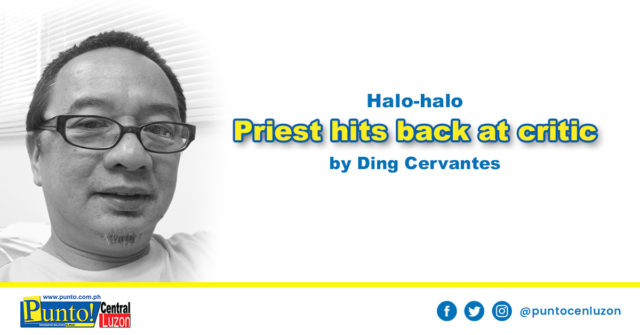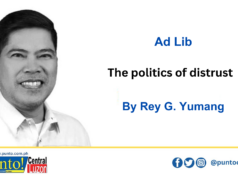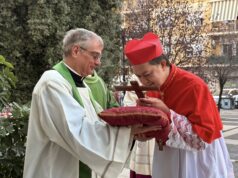IT WAS an unfortunate Sunday Mass officiated by a young, promising priest. He had apparently read my article lamenting the practice, often during homilies, of priests asking the faithful do acts I perceived to be outside the realm of good reason, even possibly beyond liturgical peripheries.
And he obviously took offense by using that Sunday Mass to virtually hit back at this critic.
I wrote in one of my columns: “Honestly, do you feel when, during Mass, the priest asks you to look at the person (stranger or not) beside you and ask: Mahal mo ba ako? Mabango ba ako? Makasalanan ka ba? Naligo ka na ba? Etc.
“This is widespread practice at least in Pampanga, making me wonder whether the Archdiocese of San Fernando had at one time mandated or at least recommended this for some purpose.
“The practice is at times done at the start of the Mass when the priest requires all to greet the other ‘Good morning’ or ‘Good afternoon’ or ‘Good evening.’ This would appear to be safe, although unnecessary.
“But during the homily, a dose of such social interaction is often liberally imposed, pushing the faithful to brief bursts of laughter, or shy half compliance, or other reactions that divert from the initial solemnity.
“I am fully convinced of the wrongness of it.
“It’s not as a matter of ego as of insult that some ignore the socialization call which, I feel, is not even worthy of kindergarten consideration. It’s beyond good reason to impose declarations that could lead to extreme awkwardness, even disrepair of human relationships, as when the next person is physically unattractive or has halitosis when the priest demands that everyone inquire into the beauty or fresh breath of the other.”
The young priest, he who I initially had thought to have saintly potential, went the opposite of what I wrote, in a manner that was sevenfold his past homilies.
In a spirited homily, he asked the faithful to look at each other eye to eye and repeat phrase per phrase what he dictated to them and, lo, to even sniff each other.
At a certain point, he also mandated church attendees to clap for themselves. This, after I also had quoted in my column Pope Benedict XVI saying “Wherever applause breaks out in the liturgy because of some human achievement, it is a sure sign that the essence of liturgy has totally disappeared and been replaced by a kind of religious entertainment.”
It would have been welcome for me to be invited by him to explain what he thought of my criticism. But to use the Holy Mass for virtual vendetta is simply spiritually gross.
But even this very moment, I have only forgiveness for him, and prayers that through the next years, his ministry would be one of apostleship. I have seen in him the potential of being a great preacher because he has good command of himself, a confidence needed by to push through these apocalyptic times.
In this regard, let me share some information from the Homiletic Directory published by the Congregation for Divine Worship and the Sacraments and approved by Pope Francis. It was released along with an appendix of passages from the catechism matched to each of the three readings for the three-year cycle of Sunday Masses and major holy days.
Guinean Cardinal Robert Sarah, prefect of the worship congregation, noted that for many Catholics the homily, experienced as “beautiful or awful, interesting or boring,” is their basis for judging an entire Mass.
Montfort Missionary Fr. Corrado Maggioni, congregation undersecretary, said lay people can help priests by expressing their views on the homilies.
“We priests may need someone to tell us: ‘It’s too long,’ ‘It’s too repetitive’ or maybe ‘Little notes might help you not go off on a thousand tangents,’” he said.
Then Pope Benedict XVI had asked the congregation to draw up the directory after many participants at the 2005 Synod of Bishops on the Eucharist and the 2008 synod on the Word of God requested a handbook to help priests with their homilies.
The directory says that “preaching at Mass, the homilist should show people how God’s word is being fulfilled in their midst, how it calls them to growth and conversion and how it prepares them to celebrate the Eucharist.”
It notes that “the homily in some sense parallels the distribution of the Lord’s body and blood to the faithful during the Communion rite,” and that “In the homily God’s holy word is ‘distributed’ for the nourishment of his people.”
The directory also says that in general, an effective homily always requires prayer, preparation, knowledge of the people who will be in the congregation, a reflection on what is happening in the community and the world, and an invitation to the Holy Spirit “as the principal agency that makes the hearts of the faithful amenable to the divine mysteries.”
“The homily will be delivered in a context of prayer and it should be composed in a context of prayer.” Facebook-type socialization is definitely out of this ken.
While the directory offers suggestions for how to tie specific Sunday readings to church teaching on a variety of theological and moral topics, it insists a homily cannot “address some issue completely unrelated to the liturgical celebration and its readings” or “do violence to the texts provided by the church by twisting them to fit some preconceived idea.”
The directory also says that “the homily is not catechetical instruction, even if catechesis is an important dimension of the homily,” and that while the preacher’s personal experience can help illustrate a point, “the homily should express the faith of the church and not simply the priest’s own story.”
My past column was titled “Scandal in Holy Masses in Pampanga, elsewhere?” I wrote in that piece that In the Church’s vocabulary, the word “Scandal” means just what it means in the Bible: a stumbling block, something that obstructs a person’s way to the faith (Matt. 18:6–9). This was to drive home the point that needless social interactions during the homily diverts from the intent to be in solemn communion with God. After all, the rest of the week is spent with us Facebooking or rubbing elbows with each other.
My column may have caused some priests to feel scandalized, but that was never my intent. My motivation was pivoted in my desire for priests to be saintly, borne of my fear of what the Blessed Mother said during her apparition in Garabandal, Spain on June 18,1965: “Many cardinals, many bishops and many priests are on the road to perdition and are taking many souls with them.”





